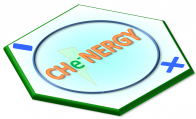CHENERGY - Chemistry and Energy Technologies
Mission
The group focuses its research activities in the field of applied science (particularly, chemistry) for energy-related applications. The range of research activities spans from the fundamentals of energy and matter, their transformations, the development and characterisation of materials and prototypes in view of engineering-related applications, addressed both through experimental and modelling (multi-scale and system levels) activities. Leading research fields are focused on the development of energy storage (lithum and post-lithium batteries, hydrogen-storage materials) and conversion (next-generation photovoltaic and photoelectrochromic) devices, hydrogen and fuel cells, catalytic combustion, solar fuels, artificial and natural photosynthesis, advanced polymer nano-composites for intensified heat exchange. Particular emphasis is devoted to the development of sustainable materials, processes and components under the guidance of life-cycle-assessment studies.
Main targets
- Development of innovative polymer electrolytes for new-generation (post-lithium) rechargeable batteries able to combine high performance (ionic conductivity at room temperature: 104 S cm1) with preparations processes being easily upscalable and with low environmental impact.
- Synthesis (through conversion of organic wastes by food and/or paper industry) and optimization of electrode materials for Li- and/or Na-ion cells having lower cost, greater safety and performance at least equal to or higher than current graphite-based electrode materials (> 350 mAh g1, 500 cycles at 100 % DoD, C-rate > 2C).
- Development of advanced materials and sustainable up-scalable assembly techniques to get record efficiency (>20%) lab-scale 3rd generation photovoltaic devices (perovskite- and/or dye-sensitized solar cells), able to efficiently operate for at least 1000 hours under real weathering outdoor conditions.
- Development of nanosized cathode materials having specific energy of 900 Wh/kg (i.e., at least 180 Ah/kg and potential > 4.5 V vs. lithium), in order to achieve high energy density Li-ion batteries (>250 Wh/kg).
- Development and characterization of electroactive materials for high-performance Li-ion batteries (> 270 Wh/kg and < 200 €/kWh).
- Development and characterization of innovative
- Development of magnetic nanocomposites for the concentration and detection of nucleic acids and proteins in both model solutions and complex matrices (e.g. blood)
-
Development of hybrid nanotubes and nanocatalytists for (photo)catalytic applications (example: removal of N-containing moieties from polluted water).
materials to achieve 500 Wh/Kg stable LiS cell.
- Obtaining structural information on the interaction of Photosystems II in thylakoid membranes of eukaryotes and biochemical-functional information on Photosystem II of unicellular organisms grown in photobioreactors in different conditions.
- Obtaining thermally conductive nanocomposites by the inclusion of chemically functionalized graphene for the improvement of thermal contacts between nanoparticles
- Obtaining graphene-based nanostructured coatings for flame protection of polymer composites and foams
- Obtaining a thermal storage system based on advanced thermochemical storage materials
Leader
Research teams
-
Group for Applied Materials and Electrochemistry
GAME
Leader: GERBALDI CLAUDIO
Permanent staff: ELIA GIUSEPPE ANTONIO , MELIGRANA GIUSEPPINA , SARACCO GUIDOResearchers (RTDA): DARJAZI HAMIDEH , PIOVANO ALESSANDRO
PhD, Post-docs and Grant researchers:
 FALCO MARISA , GAMBINO FRANCESCO , GASTALDI MATTEO , MILANESI MATTEO , PINNA LAURA , PORPORATO SILVIA , SAFFIRIO SOFIA , SPERATI VALERIA , ZHANG MINGJIE , ZHANG YING
FALCO MARISA , GAMBINO FRANCESCO , GASTALDI MATTEO , MILANESI MATTEO , PINNA LAURA , PORPORATO SILVIA , SAFFIRIO SOFIA , SPERATI VALERIA , ZHANG MINGJIE , ZHANG YING
-
Surface Chemistry of Materials
SURF-CHEM
Leader: BONELLI BARBARA
Permanent staff: ARMANDI MARCO , ESPOSITO SERENAResearchers (RTDA): FREYRIA FRANCESCA STEFANIA , TAMMARO OLIMPIA
PhD, Post-docs and Grant researchers:
 BLANGETTI NICOLA , BUCCHIERI MICHELE , CHANNA NAJEEBULLAH , NEMATI TOHID
BLANGETTI NICOLA , BUCCHIERI MICHELE , CHANNA NAJEEBULLAH , NEMATI TOHID
-
Green Energy & Engineering
Gre.En2
Leader: SPECCHIA STEFANIA
PhD, Post-docs and Grant researchers:
 MAZZEI HERNAN GABRIEL
MAZZEI HERNAN GABRIEL
-
CHemistry and Science of Polymers and Composites
ChaMP
Leader: FINA ALBERTO
Permanent staff: BATTEGAZZORE DANIELE , CAROSIO FEDERICO , IACONO GIUSEPPINAResearchers (RTDA): MADDALENA LORENZA
PhD, Post-docs and Grant researchers:
 ABBA' LORENZA , MARCIONI MASSIMO , MHEDHBI HOUDA , PARAVIDINO CHIARA , PELLEGRINO ENRICA , ZHAO HUI
ABBA' LORENZA , MARCIONI MASSIMO , MHEDHBI HOUDA , PARAVIDINO CHIARA , PELLEGRINO ENRICA , ZHAO HUI
-
Electrochemistry
Permanent staff: AMICI JULIA GINETTE NICOLE , BELLA FEDERICO , BODOARDO SILVIA , FRANCIA CARLOTTA , GATTI TERESA , KRIEGEL ILKA
Researchers (RTDA): VERSACI DANIELE
PhD, Post-docs and Grant researchers:
 ABBASPOOR ZANJANI SOGAND , BENIGNO ANTONIO , CABONA ANNA , COLOMBO ROBERTO , DOMENICI SARA , FERRO LAURA , FLORES GARCIA JENNY , GARCIA BALLESTEROS SARA , KURIYIL SIDHARTH , LONGO MATTIA , LUCIANO LEONARDO ALBERTO , LUPATELLI TOMMASO FILIPPO , MANGINI ANNA , MARONGIU MARCO , MARTIN IRENE , MIRONE ALICE , MONTINARO GIORGIO , MUSCATELLO ANDREA , PADUA ALESSANDRO , PETRINI NICOLO' , PIRRONE NOEMI , POZZATI MICAELA , QUERIO ANDREA , RAVESIO ELISA , RAVIOLO SOFIA , RIZZO MARTINA , SIBELLA LORENZO , TALLONE PAOLO , TAMBOIA LORENZO , TRANO SABRINA , VAEZ SAMANEH , WANG MENGJIAO
ABBASPOOR ZANJANI SOGAND , BENIGNO ANTONIO , CABONA ANNA , COLOMBO ROBERTO , DOMENICI SARA , FERRO LAURA , FLORES GARCIA JENNY , GARCIA BALLESTEROS SARA , KURIYIL SIDHARTH , LONGO MATTIA , LUCIANO LEONARDO ALBERTO , LUPATELLI TOMMASO FILIPPO , MANGINI ANNA , MARONGIU MARCO , MARTIN IRENE , MIRONE ALICE , MONTINARO GIORGIO , MUSCATELLO ANDREA , PADUA ALESSANDRO , PETRINI NICOLO' , PIRRONE NOEMI , POZZATI MICAELA , QUERIO ANDREA , RAVESIO ELISA , RAVIOLO SOFIA , RIZZO MARTINA , SIBELLA LORENZO , TALLONE PAOLO , TAMBOIA LORENZO , TRANO SABRINA , VAEZ SAMANEH , WANG MENGJIAO
Additional contents

